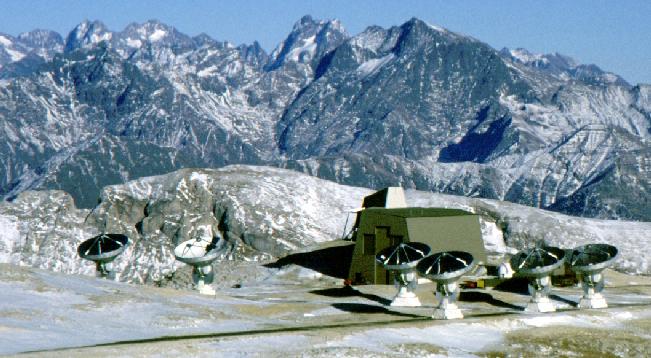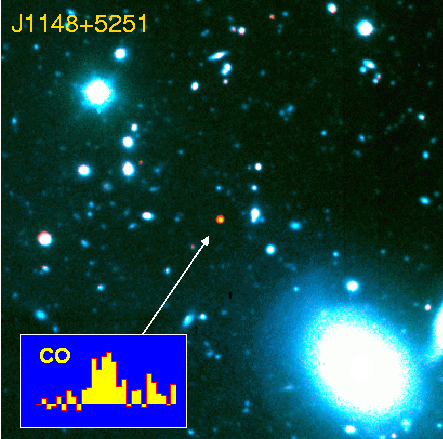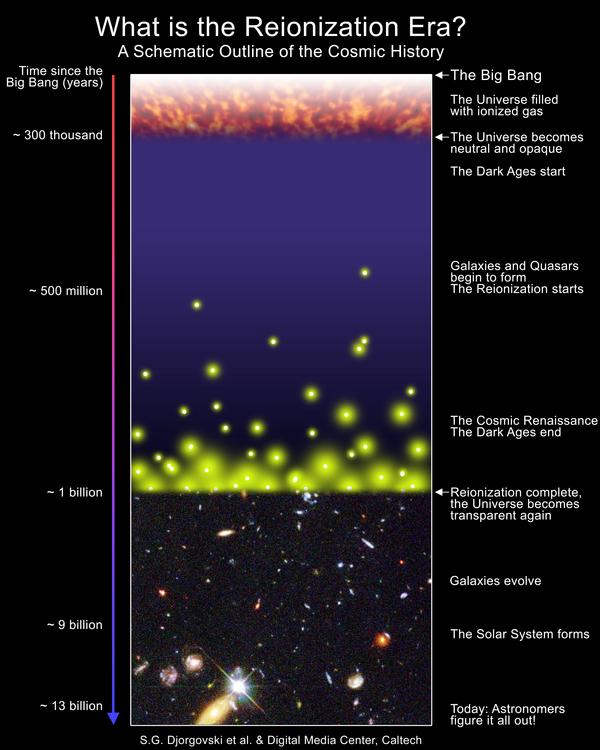
| PRI (MPIfR) 07/03 (4) [German] | Press Release | EMBARGOED: 18h GMT, July 23, 2003 |
Such Stuff As Stars Are Made On
Astronomers discover a giant reservoir of gas and dust in the most distant quasar known.
Scientists at the Max-Planck-Institute for Radioastronomy (MPIfR) in Bonn together with their colleagues in France and the United States have discovered a huge mass of gas in the most distant quasar yet found in the Universe. The carbon monoxide gas and the dust emitted the radiation from the quasar at a time when the Universe was only one-sixteenth its current age, 850 million years after the Big Bang. These observations allowed for the first time to probe the conditions within the regions where the very first stars and massive black holes were forming. The CO detection is presented in the July 24 issue of the scientific journal Nature, and in a complementary article for the journal Astronomy and Astrophysics.
"We were much surprised to see such vast amounts of heavy elements at such early times, so soon after the Big Bang," delights Frank Bertoldi from the MPIfR. "Since carbon, oxygen, and the elements making up the dust grains are created through nuclear fusion reactions within stars, the enrichment of the interstellar gas must have been unusually fast, possibly though the violent explosions of the first massive stars."
The carbon monoxide (CO) gas was revealed by the observations made at the IRAM Plateau de Bure Interferometer (France) and the Very Large Array in New Mexico (USA), and the dust emission was previously discovered using the MAMBO heat detector at the IRAM 30-meter telescope, which is located at Pico Veleta near Granada, Spain (MPIfR PR 03/03(2)).
The yet most distant quasar known, which is named after its sky coordinates, J1148+5251, was discovered earlier this year from the Sloan Digital Sky Survey by Xiaohui Fan (University of Arizona) and his collaborators. It is a young galaxy including one of the most massive central black holes known, containing several billion times the mass of our Sun and radiating brightly in optically visible light as it swallows its surrounding matter. Being among the first such massive structures to have formed in the Universe, its discovery provides scientists with a direct view of the physical and chemical conditions in galaxies when the Universe was very young.
 |
Figure 1: Carbon monoxide (CO)
emission from the most distant quasar yet known, SDSS
J1148+5251, is seen in this radio image, which is tuned to
one of the characteristic CO emission line frequencies. The
insert shows how the radiation intensity at the position of
the quasar depends on frequency, revealing the CO emission
bump at the expected frequency. These observations were
taken with the IRAM Plateau de Bure Interferometer. A lower
frequency CO emission line was also detected with the
VLA, and an upper limit to the intensity of the lowest
frequency CO line was established with the Effelsberg
100-meter telescope near Bonn.
In the image, red indicates the highest intensity, blue
the lowest, and the contour lines follow the intensity
levels.
[ Version2, Version3, Version4, image, line ] |
 |
| Figure 2: The Plateau de Bure Interferometer of IRAM (Institute for Radioastronomy at Millimeter Wavelengths) on the summit of the Pic de Bure mountain in the French Alps. Each of the six radio antennas has a diameter of 15 meters. The IRAM interferometer is the most powerful observatory for millimeter wavelength radiation. (Credit: A. Rambaud/IRAM) [ Full image, different image ] |
J1148+5251 is one of only five objects yet identified near the end of the "Dark Ages" of the Universe (Figure 4). The discovery of dust and molecular emission makes it the first object to allow detailed studies of star formation during an important epoch of the Universe, a time when it transformed from a grey fog to a bright space in which galaxies, stars, and flashing black holes were forming at an ever accelerating pace. As a bright source of ultraviolet radiation, J1148+5251 contributes notably to the re-ionization of the matter between galaxies, providing astronomers with an important first object whose contribution to the "lifting of the cosmic fog" can be measured directly.
J1148+5251 was detected because of the immense optical brightness of the hot material falling into its active black hole. The detection of CO and dust emission now gives astronomers an indirect look at the galaxy hosting the black hole, a galaxy too faint to be seen in current optical images. The CO radiation now reveals important information about the density, temperature, and size of the dense molecular center of that galaxy, a region surrounding the massive black hole where a new star is born about every five hours, at a rate much higher than that seen in any galaxy in the local Universe.
Although dust and carbon monoxide are rare trace components in a gas consisting primarily of hydrogen molecules, the amount of dust and carbon monoxide seen indicates that its formation mechanism must have been very efficient and fast, astronomically speaking. Carbon and oxygen, which make up carbon monoxide, had to be made in the thermonuclear furnaces of the earliest stars.
"Ten years ago no one would have thought that huge masses of dust and heavy elements already existed so soon after the Big Bang," recalls Dr. Bertoldi. " Since the original, pristine cosmic matter did not contain any of those elements, the very first stars forming in the Universe must have bred them and then ejected them into the interstellar medium with surprising efficiency, through their strong winds, or during the supernova explosions marking the end of massive stars. Apparently this lead to enrichments of heavy elements in the surrounding gas rather similar to what we find today, some 13 billion years later, in the interstellar medium of neighbouring galaxies."

|
Figure 3: A true-color optical image of J1148+5251, obtained at the Keck 10-meter telescope, with the IRAM CO spectrum of the quasar shown as an insert. Due to it distance the quasar's light is shifted to redder colors by a factor 7.42, and stands out as an unusually red object. All other objects in the image are far less distant galaxies. The image measures about 1/30 of a degree (1/15 of the diameter of the Moon) on each side. (Image credit: Keck image by S.G. Djorgovski, A. Mahabal, and M. Bogosavljevic, Caltech) [image only] |
From the frequency widths (Figure 1) and the relative intensities of the three CO emission lines detected in J1148+5251, astronomers are able to estimate the size of the emission region to be several thousand light years. "This may sound large," explains Professor Karl Menten from the MPIfR, "but is is still so tiny a region in the sky that no present telescope could resolve details in such a distant object. The line emission provides us with a unique, although indirect way to look at the size, density, and temperature in this amazingly active region of star formation around an active black hole." The researchers thereby computed that the amount of gas present in J1148+5251, about 20 billion solar masses, would last less than 10 million years before it all turned into stars, if star formation continued at the current rate. Astronomer suspect that less dense, atomic gas might fall onto the star forming region, feeding it continuously, or if supplies ran out, starving it into quiescence. "Who knows what happened next," Dr. Bertoldi wonders, "we only get this snapshot from J1148+5251. To better understand the cause and evolution of star formation and black hole growth in the early Universe, we now need to find other, similar objects, and then compare them."
Although more discoveries are expected with the IRAM interferometer and with the VLA in the coming years, astronomers are looking forward to the far more powerful ALMA radio interferometer to be built, through a large international collaboration, in the Chilean Atacama desert after 2007.
[ELN]
Publications:
The discovery of CO in J1148+5251 will appear in an article in the July 24th issue of Nature, led by the German astrophysicist Fabian Walter from the VLA/NRAO, USA, and in a Letter to Astronomy and Astrophysics led by Frank Bertoldi (MPIfR Bonn, Germany). Other team members include Karl Menten and Christian Henkel (MPIfR), Chris Carilli and Fred Lo (NRAO, USA), Pierre Cox and Alexandre Beelen (IAS, France), Roberto Neri (IRAM, France), and Alain Omont (IAP, France). Xiaohui Fan of the University of Arizona's Steward Observatory and Michael Strauss of Princeton University were the Sloan Digital Sky Survey collaborators who first discovered the quasar. The detection of dust emission from the quasar is described in a recent letter to Astronomy and Astrophysics.
- F. Bertoldi, P. Cox, R. Neri, C.L. Carilli, F. Walter, A. Omont, A. Beelen, C. Henkel, X. Fan, M.A. Strauss, K.M. Menten, "High-excitation CO in a quasar host galaxy at z=6.42", Astronomy and Astrophysics Letters, in press. [pdf]
- F. Walter, F. Bertoldi, C. Carilli, P. Cox, K.Y. Lo, R. Neri, X. Fan, A. Omont, M.A. Strauss, K.M. Menten, "Molecular gas in the host galaxy of a quasar at redshift z=6.42", Nature, 24. July 2003, [pdf, link to Nature report]
- F. Bertoldi, C.L. Carilli, P. Cox, X. Fan, M.A. Strauss, A. Beelen, A. Omont, R. Zylka, "Dust emission in z>6 quasars", Astronomy and Astrophysics Letters, in press. [pdf]
 |
| Figure 4: A brief history of the Universe. During the first three minutes after the Big Bang only the smallest atoms, hydrogen and helium, were formed. Initially they were ionized (stripped of their electrons) as the Universe was still hot and dense. As the Universe expanded, the gas cooled, and after about 300,000 years, when the temperature dropped to about 5000 degrees, the atomic nuclei and electrons were able to combine to form entire atoms. Since no sources of light were present and because the atoms were able to absorb much of the light emerging from the very first stars that formed after a few hundred million years, cosmologists refer to this period as the "Dark Ages" of the Universe. When ever more stars formed, their radiation again knocked the electrons from the atoms and the Universe became ever more transparent; its fog lifted. This "Era of Reionization" was completed about one billion years after the Big Bang; now the Universe had matured to one full of light and evolution. (Graphic credit: S.G. Djorgovski and the Caltech Digital Media Center) [Full resolution image (1.1M)] |
|
For further information please contact:
Dr. Frank Bertoldi
Dr. Norbert Junkes (MPIfR public outreach) |
German version of this Press Release |